
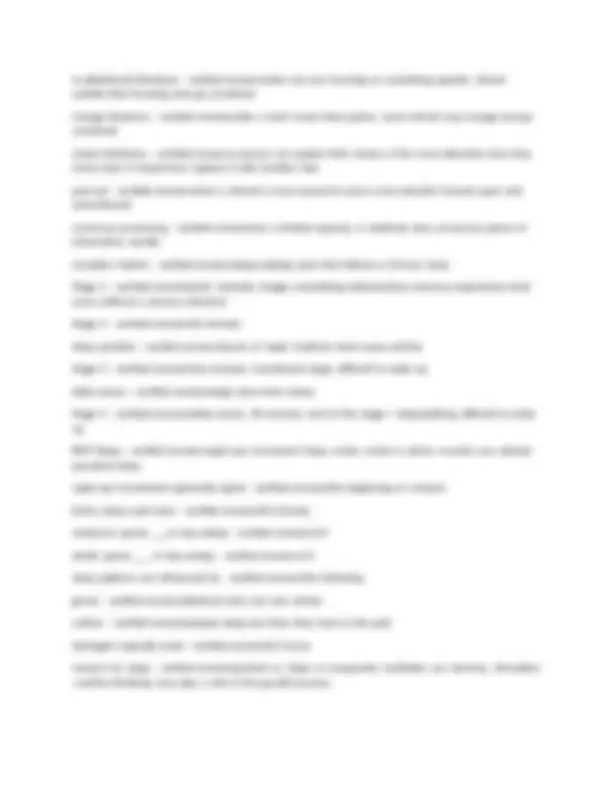
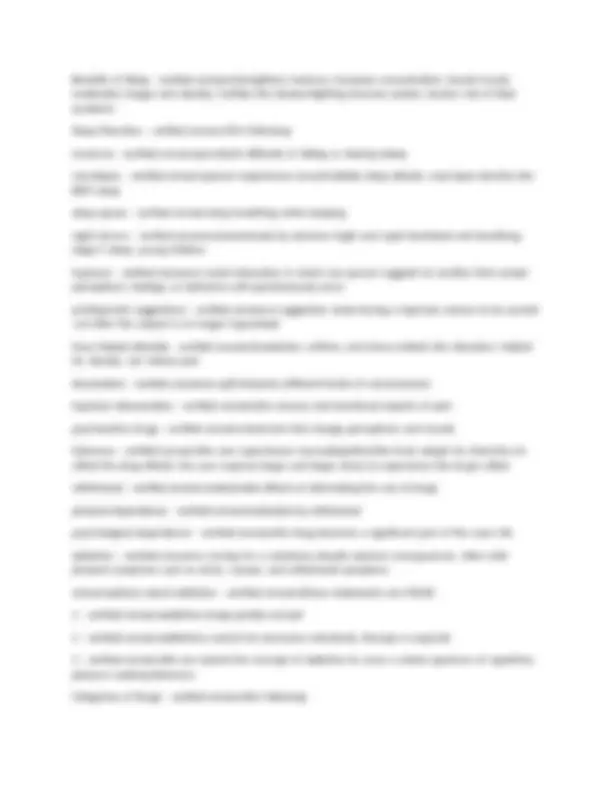
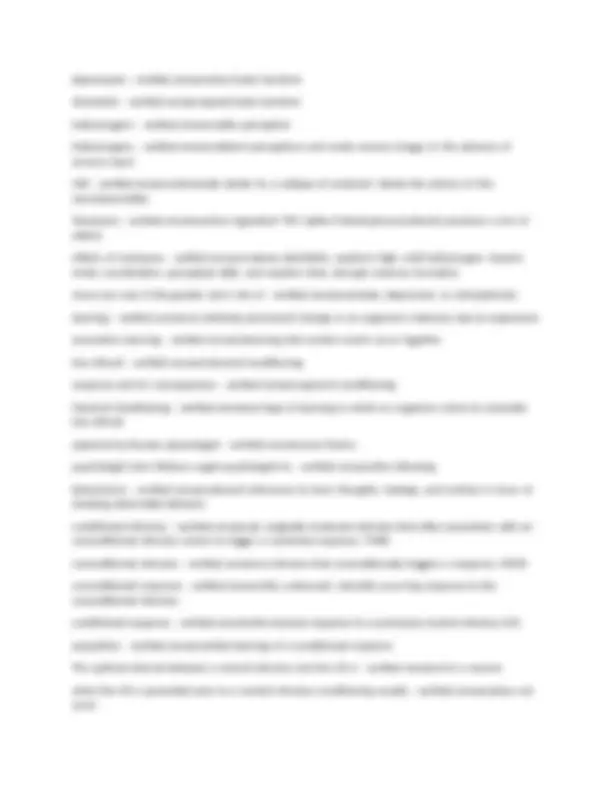
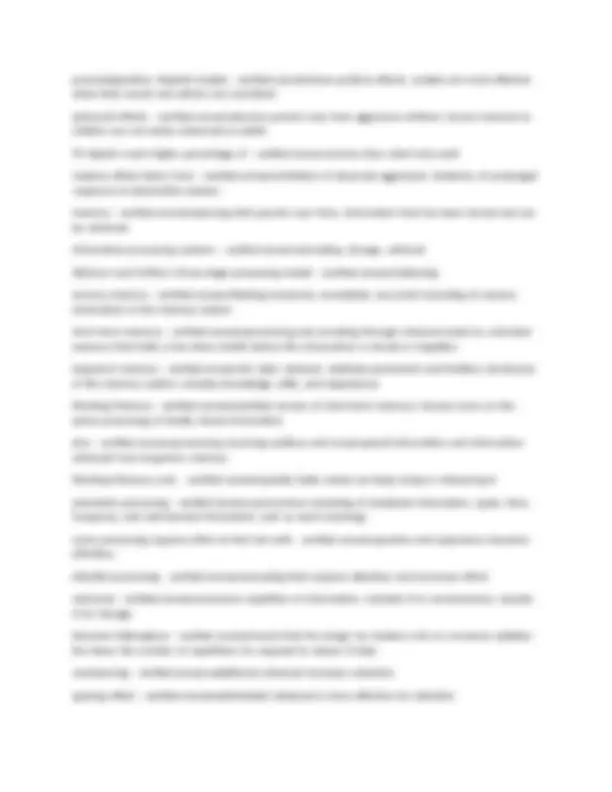
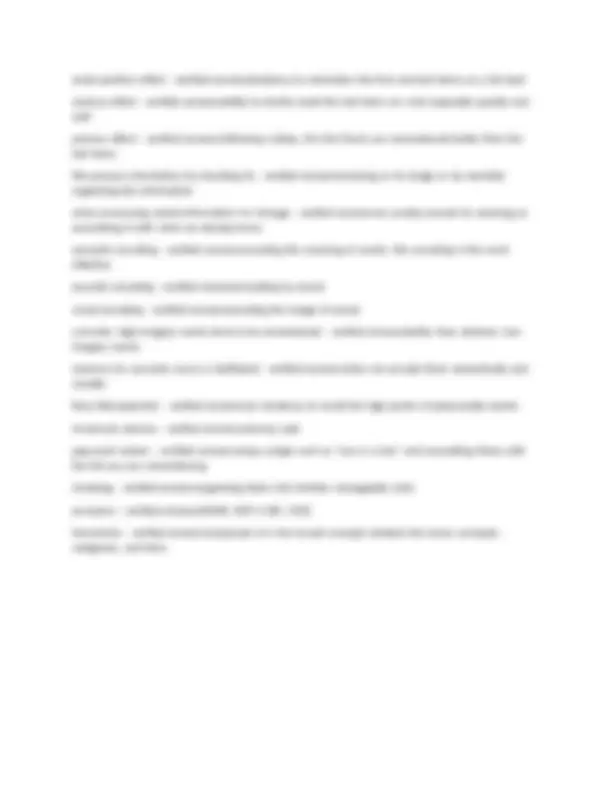


Study with the several resources on Docsity

Earn points by helping other students or get them with a premium plan


Prepare for your exams
Study with the several resources on Docsity

Earn points to download
Earn points by helping other students or get them with a premium plan
Community
Ask the community for help and clear up your study doubts
Discover the best universities in your country according to Docsity users
Free resources
Download our free guides on studying techniques, anxiety management strategies, and thesis advice from Docsity tutors
UCLA Psych 101 Exam #2 Study Guide Verified Question
Typology: Exams
1 / 9

This page cannot be seen from the preview
Don't miss anything!






sensation |- |verified |answersthe |way |that |our |bodies |sense |stimuli perception |- |verified |answershow |our |brains |process |the |stimuli |sensed |by |our |body top-down |processing |- |verified |answersinformation |processing |guided |by |a |higher-level |mental | processes bottom-up |processing |- |verified |answersanalysis |that |begins |with |the |sensory |receptors absolute |threshold |- |verified |answersthe |minimum |stimulation |necessary |for |detection |50% |of |the | time difference |threshold |- |verified |answersthe |minimum |difference |a |person |can |detect |between |any |two | stimuli |50% |of |the |time Weber's |Law |- |verified |answersfor |their |difference |to |be |perceptible, |two |stimuli |must |differ |by |a | constant |proportion- |not |a |constant |amount. Sensory |Adaptation |- |verified |answersour |diminishing |sensitivity |to |an |unchanging |stimulus wavelength |- |verified |answersthe |distance |from |one |wave |peak |to |the |next; |determines |hue intensity |- |verified |answersamount |of |energy |in |light |waves; |determined |by |a |waves |amplitude | (height); |influences |brightness accommodation |- |verified |answersfocuses |by |changing |its |curvature blind |spot |- |verified |answerswhere |the |optic |nerve |lease |the |eye |there |are |no |receptor |cells Cones |- |verified |answerscluster |around |the |fovea |(retina's |area |of |central |focus); |each |has |its |own | bipolar |cell; |preserves |precise |information; |can |see |color; |can't |function |in |dim |light Rods |- |verified |answersblack |and |white |vision; |capable |in |dim |light Young-Helmholtz |trichromatic |theory |- |verified |answersretina |has |three |types |of |color |receptors, |each |especially |sensitive |to |red, |green, |and |blue Opponent-process |theory |- |verified |answersas |visual |information |leaves |the |receptor |cells, |we |analyze |it |in |terms |of |the |opponent |colors What |are |the |opponent |colors? |- |verified |answersred |and |green, |blue |and |yellow, |black |and |white Gate-Control |Theory |- |verified |answersspinal |cord; |small |nerve |fibers |conduct |most |pain |signals, | larger |fibers |conduct |most |other |sensory |signals; |spinal |cord |contains |a |neurological |"gate" |when | tissue |is |injured, |the |small |fibers |activate |and |open |the |gate |and |you |feel |pain Taste |- |verified |answerssweet |salty |sour |bitter |umami
Sensory |Interaction |- |verified |answersone |sense |may |influence |another; |when |smell |is |blocked |foods | don't |taste |the |same gestalt |- |verified |answersmeaning |"form" |or |a |"whole": |when |given |a |cluster |of |sensations |people | tend |to |organize |them |into |one |of |these figure-ground |- |verified |answerswe |always |organize |the |stimulus |into |a |figure |seen |against |a |ground Grouping |- |verified |answerscategorizing |stimuli |by: continuity |- |verified |answerssmooth |continuous |patterns closure |- |verified |answersfill |in |gaps |to |create |a |complete |whole |object proximity |- |verified |answersgrouping |of |items |that |are |close |to |each |other similarity |- |verified |answersgrouping |of |items |that |look |alike connectedness |- |verified |answerstendency |to |perceive |uniform |or |attached |items |as |a |single |unit Depth |Perception |- |verified |answersthe |ability |to |see |objects |in |three |dimensions |despite |their |two- dimensional |representations |on |retinas; |allows |us |to |estimate |distance visual |cliff |- |verified |answersby |the |time |a |species |is |mobile |it |has |the |perceptual |abilities |it |needs visual |cues |- |verified |answersfactors |that |provide |us |with |depth |perception binocular |cues |- |verified |answersany |cue |that |requires |the |use |of |both |eyes retinal |disparity |- |verified |answersthe |greater |the |difference |between |the |images |received |by |the |two |eyes, |the |nearer |the |object monocular |cues |- |verified |answersany |cue |that |requires |either |eye |alone relative |size |- |verified |answersif |we |assume |two |objects |are |similar |in |size, |most |people |perceive |the | one |that |casts |the |smaller |retinal |image |as |further |away interposition |- |verified |answersif |an |object |partially |blocks |our |view |of |another |it |is |perceived |as | closer relative |height |- |verified |answerswe |perceive |objects |higher |in |our |field |of |vision |as |farther |away relative |motion |- |verified |answerson |a |moving |vehicle, |objects |far |away |from |our |fixation |point |seem | to |move |faster linear |perspective |- |verified |answersparallel |lines |appear |to |converge |with |distance light |and |shadow |- |verified |answersnearby |objects |reflect |more |light |to |our |eyes; |dimmer |objects | seem |to |be |further |away selective |attention |- |verified |answersour |awareness |focuses |on |only |a |limited |aspect |of |all |that |we | experience
Benefits |of |Sleep |- |verified |answersstrengthens |memory; |increases |concentration; |boosts |mood; | moderates |hunger |and |obesity; |fortifies |the |disease-fighting |immune |system; |lessens |risk |of |fatal | accidents Sleep |Disorders |- |verified |answersThe |Following insomnia |- |verified |answerspersistent |difficulty |in |falling |or |staying |asleep narcolepsy |- |verified |answersperson |experiences |uncontrollable |sleep |attacks; |may |lapse |directly |into | REM |sleep sleep |apnea |- |verified |answersstop |breathing |while |sleeping night |terrors |- |verified |answerscharacterized |by |extreme |fright |and |rapid |heartbeat |and |breathing; | stage | 4 |sleep; |young |children hypnosis |- |verified |answersa |social |interaction |in |which |one |person |suggests |to |another |that |certain | perceptions, |feelings, |or |behaviors |will |spontaneously |occur posthypnotic |suggestions |- |verified |answersa |suggestion |made |during |a |hypnosis |session |to |be |carried |out |after |the |subject |is |no |longer |hypnotized have |helped |alleviate |- |verified |answersheadaches, |asthma, |and |stress-related |skin |disorders; |helpful | for |obesity; |can |relieve |pain dissociation |- |verified |answersa |split |between |different |levels |of |consciousness hypnosis |disassociates |- |verified |answersthe |sensory |and |emotional |aspects |of |pain psychoactive |drugs |- |verified |answerschemicals |that |change |perceptions |and |moods tolerance |- |verified |answersthe |user |experiences |neuroadaptation(the |brain |adapts |its |chemistry |to | offset |the |drug |effect); |the |user |requires |larger |and |larger |doses |to |experience |the |drug's |effect withdrawal |- |verified |answersundesirable |effects |of |eliminating |the |use |of |drugs physical |dependence |- |verified |answersindicated |by |withdrawal psychological |dependence |- |verified |answersthe |drug |becomes |a |significant |part |of |the |users |life addiction |- |verified |answersa |craving |for |a |substance |despite |adverse |consequences; |often |with | physical |symptoms |such |as |aches, |nausea, |and |withdrawal |symptoms misconceptions |about |addiction |- |verified |answers(these |statements |are |FALSE) 1 |- |verified |answersaddictive |drugs |quickly |corrupt 2 |- |verified |answersaddictions |cannot |be |overcome |voluntarily, |therapy |is |required 3 |- |verified |answersWe |can |extend |the |concept |of |addiction |to |cover |a |whole |spectrum |of |repetitive, | pleasure |seeking |behaviors Categories |of |Drugs |- |verified |answersthe |following
depressants |- |verified |answersslow |body |functions stimulants |- |verified |answersspeed |body |functions hallucinogens |- |verified |answersalter |perception hallucinogens |- |verified |answersdistort |perceptions |and |evoke |sensory |images |in |the |absence |of | sensory |input LSD |- |verified |answerschemically |similar |to |a |subtype |of |seratonin: |blocks |the |actions |of |this | neurotransmitter Marijuana |- |verified |answersactive |ingredient |THC |(delta-9-tetrahydrocannabinol) |produces |a |mix |of | effects effects |of |marijuana |- |verified |answersrelaxes |disinhibits; |euphoric |high; |mild |hallucinogen; |impairs | motor |coordination, |perceptual |skills, |and |reaction |time; |disrupts |memory |formation more |one |uses |it |the |greater |one's |risk |of |- |verified |answersanxiety, |depression, |or |schizophrenia learning |- |verified |answersa |relatively |permanent |change |in |an |organism's |behavior |due |to |experience associative |learning |- |verified |answerslearning |that |certain |events |occur |together two |stimuli |- |verified |answersclassical |conditioning response |and |it's |consequences |- |verified |answersoperant |conditioning Classical |Conditioning |- |verified |answersa |type |of |learning |in |which |an |organism |comes |to |associate | two |stimuli explored |by |Russian |physiologist |- |verified |answersIvan |Pavlov psychologist |John |Watson |urged |psychologist |to |- |verified |answersthe |following behaviorism |- |verified |answersdiscard |references |to |inner |thoughts, |feelings, |and |motives |in |favor |of | studying |observable |behavior conditioned |stimulus |- |verified |answersan |originally |irrelevant |stimulus |that |after |association |with |an | unconditioned |stimulus |comes |to |trigger |a |condoned |response, |TONE unconditioned |stimulus |- |verified |answersa |stimulus |that |unconditionally |triggers |a |response, |FOOD unconditioned |response |- |verified |answersthe |unlearned, |naturally |occurring |response |to |the | unconditioned |stimulus conditioned |response |- |verified |answersthe |learned |response |to |a |previously |neutral |stimulus |(CS) acquisition |- |verified |answersinitial |learning |of |a |conditioned |response The |optimal |interval |between |a |neutral |stimulus |and |the |US |is |- |verified |answers1/2 |a |second when |the |US |is |presented |prior |to |a |neutral |stimulus |conditioning |usually |- |verified |answersdoes |not | occur
negative |reinforcer |- |verified |answersstrengthens |a |response |by |reducing |or |removing |something | undesirable |or |unpleasant; |not |a |punishment, |removes |a |punishing |agent Primary |and |Conditioned |- |verified |answersfollowing primary |reinforcers |- |verified |answersreinforcers |related |to |basic |needs |that |do |not |rely |on |learning conditioned |reinforcers |- |verified |answersreinforcers |that |must |be |conditioned |and |therefore |derive | their |power |through |association Immediate |and |Delayed |- |verified |answersfollowing Immediate |- |verified |answersChildren |who |are |able |to |delay |gratification |tend |to |become |more | socially |competent |and |high |achieving |as |they |mature immediate |reinforcement |- |verified |answersis |more |efficient |than |delayed |reinforcement explains |- |verified |answersdrug |abuse |and |unprotected |sex Continuous |and |Partial |- |verified |answersfollowing Continuous |Reinforcement |- |verified |answersreinforcing |the |desired |response |every |time |it |occurs; | learning |is |rapid; |discontinued... |extinction |rapid partial |(intermittent) |reinforcement |- |verified |answersresponses |are |reinforced |only |some |of |the |time; |learning |is |slower; |behavior |is |very |resistant |to |extinction Types |of |partial |reinforcement |- |verified |answersfollowing fixed-ratio |- |verified |answersbehavior |is |reinforced |after |a |set |number |of |responses variable-ratio |- |verified |answersreinforcement |occurs |after |an |unpredictable |set |of |responses fixed-interval |- |verified |answersreinforcement |of |the |first |response |after |a |set |interval |of |time variable-interval |- |verified |answersfirst |response |after |varying |amounts |of |time |is |reinforced observational |learning |- |verified |answerslearning |by |observing |and |imitating |others modeling |- |verified |answerswhen |it |involves |a |specific |behavior mirror |neurons |- |verified |answers(in |a |frontal-lobe |area |adjacent |to |the |brain's |motor |cortex) |that | provide |a |neural |basis |for |observational |learning mirror |neurons |continued |- |verified |answersthese |neurons |have |been |observed |to |fire |when |monkeys |perform |a |simple |task |and |they |observe |other |monkeys |performing |the |same |task 9 |months |- |verified |answersinfants |will |imitate |novel |play |behaviors 14 |months |- |verified |answersimitate |acts |modeled |on |TV Albert |Bandura |- |verified |answerspsychologist |best |known |for |research |on |observational |learning models |are |most |effective |when |they |are |perceived |as |- |verified |answerssimilar, |successful, |or | admirable
prosocial(positive, |helpful) |models |- |verified |answershave |positive |effects; |models |are |most |effective | when |their |words |and |actions |are |consistent antisocial |effects |- |verified |answersabusive |parents |may |have |aggressive |children; |lessons |learned |as | children |are |not |easily |unlearned |as |adults TV |depicts |much |higher |percentage |of |- |verified |answerscrimes |than |what |truly |exist violence |effect |stems |from |- |verified |answersimitation |of |observed |aggression; |tendency |of |prolonged |exposure |to |desensitize |viewers memory |- |verified |answerslearning |that |persists |over |time; |information |that |has |been |stored |and |can | be |retrieved information-processing |systems |- |verified |answersencoding, |storage, |retrieval Atkinson |and |Chiffon's |three-stage |processing |model |- |verified |answersfollowing sensory |memory |- |verified |answersfleeting |memories; |immediate, |very |brief |recording |of |sensory | information |in |the |memory |system short |term |memory |- |verified |answersprocessing |and |encoding |through |rehearsal |leads |to; |activated | memory |that |holds |a |few |items |briefly |before |the |information |is |stored |or |forgotten long-term |memory |- |verified |answersfor |later |retrieval; |relatively |permanent |and |limitless |storehouse | of |the |memory |system; |includes |knowledge, |skills, |and |experiences Working |Memory |- |verified |answersclarified |version |of |short-term |memory; |focuses |more |on |the | active |processing |of |briefly |stored |information also |- |verified |answersprocessing |incoming |auditory |and |visual-spacial |information |and |information | retrieved |from |long-term |memory Working |Memory |cont. |- |verified |answersquickly |fades |unless |we |keep |using |or |rehearsing |it automatic |processing |- |verified |answersunconscious |encoding |of |incidental |information; |space, |time, | frequency, |and |well |learned |information |such |as |word |meanings some |processing |requires |effort |at |first |but |with |- |verified |answerspractice |and |experience |becomes | effortless effortful |processing |- |verified |answersencoding |that |requires |attention |and |conscious |effort rehearsal |- |verified |answersconscious |repetition |of |information; |maintain |it |in |consciousness; |encode | it |for |storage Hermann |Ebbinghaus |- |verified |answersfound |that |the |longer |he |studied |a |list |on |nonsense |syllables, | the |fewer |the |number |of |repetitions |he |required |to |relearn |it |later overlearning |- |verified |answersadditional |rehearsal |increases |retention spacing |effect |- |verified |answersdistributed |rehearsal |is |more |effective |for |retention